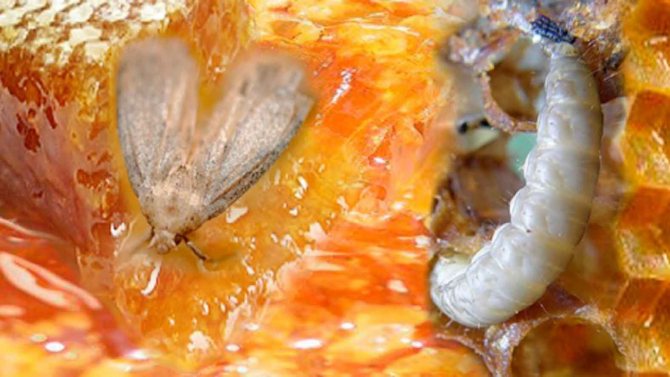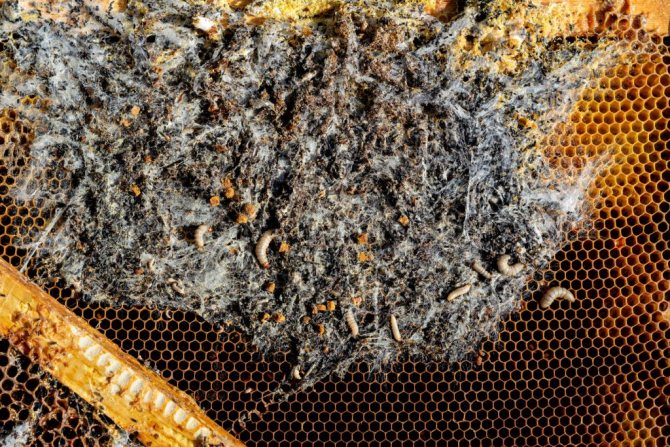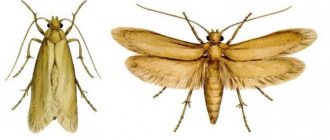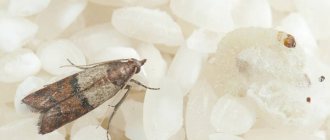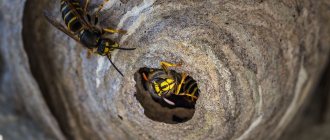The wax moth, or moth, is an inconspicuous butterfly, which is small in size and modest in color, but has gained fame as a formidable enemy of beekeeping.
The immediate danger for people engaged in breeding bees is not the butterflies themselves, but the larvae of the moth, which infect the hive in search of food. Small caterpillars harm beekeepers by eating combs and other products produced by bees.
However, wax moth can provide significant benefits. On the basis of caterpillars, drugs are produced that have almost unique medicinal properties.
Nevertheless, caterpillars are grown more often in the conditions of large beekeeping farms, smaller-scale apiaries consider moths exclusively as parasites, using all available methods and methods to combat them, which we will discuss in more detail below.
Ways to combat wax moth
How to deal with wax moths when a pest appears?
There are many different ways that can be conditionally divided into three main groups: biological, chemical, mechanical. The choice of the most suitable one is carried out by determining the degree of infection, the number of honeycombs affected by the fire, and a number of other factors.
It should be noted that bees are quite able to independently protect the hive from the invasion of pests, damage. When caterpillars penetrate, insects literally seal the larva, which leads to the death of the latter. It is for this reason that it is extremely important to provide bees with access to all the secluded corners of the hive. However, it is important to remember that only a small number of parasites can be dealt with by bees.
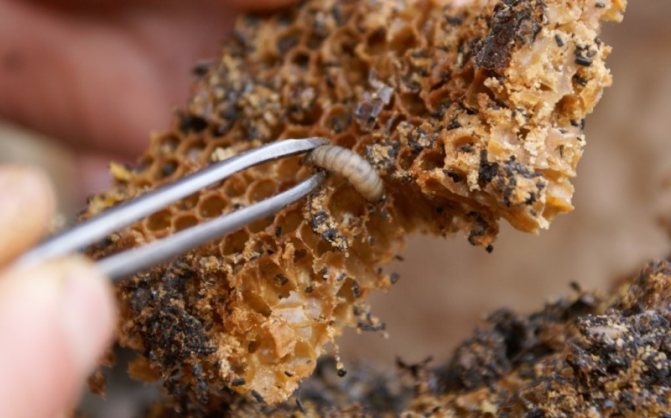
Biological method
So how to get rid of the wax moth in the hive? Beekeepers do not recommend the use of chemicals to neutralize pests with an insignificant amount of the latter. To prevent the appearance of moths, when a small number of pests appear, you can use biological methods, that is, involving the use of products of natural origin.
The leaves of immortelle, mint, walnut are excellent parasites. To eliminate the wax moth, to prevent its appearance, it is necessary to carefully pour the frames prepared for long-term storage.
An excellent remedy for parasites is mint tincture. To destroy insects, it is enough to mix it with a small amount of water, then pour it between the frames, place it for a day to dry. This product is not harmful to bees. As a rule, the use of these remedies forces the butterflies to settle away from the treated areas.
Mechanical method
But what if the moth appeared in the hives, but the use of biological, chemical agents is not possible for a number of reasons? In such a situation, it is sufficient to use a mechanical method, which involves shaking out the larvae from the frames by hand. In order for the pests to leave the shelter, it is enough to lightly knock on the frame, and then shake out the insects.


Handy and special chemicals
Before dealing with wax moths, it is recommended to carefully study the ways, methods, means that will help you do it quickly, effectively, and safely for bees. It is best, of course, to use organic products, but with a strong degree of infection, the use of tablets and chemicals may be required.
Salt treatment
The fight against wax moth includes the obligatory processing of the frames immediately before sending them to the honeycomb storage. The easiest way is to use a saturated solution of common salt. After preparing such a product, it is enough to pour the resulting concentrate into a spray bottle, and then carefully process potential affected areas. After drying, a white layer forms on the frames, which has a repellent effect on the wax moth. this measure will help to effectively protect the hull with land from the invasion of moths.
Fumigation
In case of severe damage, you can get rid of parasites on the frames by using ordinary sulfur dioxide. To destroy the parasite, it is required to fumigate the frames twice for three weeks at regular intervals, this, of course, should be done before sending the honeycomb for drying. When thinking about how to get the wax moth out of the hive, one should not forget about the benefits of these caterpillars. If a sufficient number of parasites are collected, it is quite possible to prepare a useful tincture on their basis.
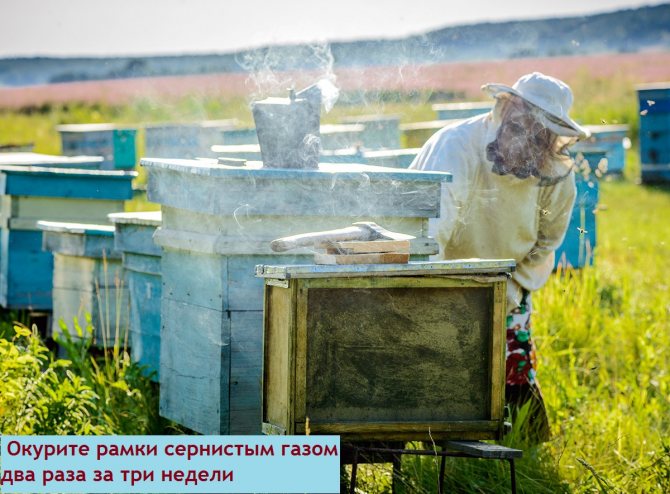

Freezing and heating
As well as against any other pest, control methods aimed at killing wax moths include exposure to high or low temperatures. You should know that the wax moth dies at temperatures below ten degrees.
In order to get rid of parasites, you can take the frames outside in winter or place them in the refrigerator. To exclude the likelihood of the survival of the parasites, it is recommended to carry out the procedure for at least two hours. Heat treatment involves the use of high temperature regimes of over fifty degrees.
Acetic or formic acid vapors
The easiest way to protect the honeycomb from wax moths is to treat the frames with formic or acetic acid.
To remove the moths, it is enough to put a small container with the selected product on the bottom of the box, and then cover it with a thin layer of polyethylene on top. It is recommended to periodically check the amount of funds, if necessary, replenish its stocks.
Folk ways
To get rid of wax moths in hives, it is recommended to use various folk methods. Knowing what the parasites are afraid of can help you achieve good results quickly. For example, in order to prevent females from leaving clutches of eggs, it is recommended to leave several containers of any kind on the site, on the bottom of which pour water mixed with sugar and honey. Despite the fact that adult butterflies do not need food, they arrive at a pleasant smell for them.
Ordinary naphthalene will help get rid of parasites. This substance should be placed directly in the hives using small boxes. To prevent a number of unpleasant consequences, it is recommended to remove these capsules during the main honey collection period.
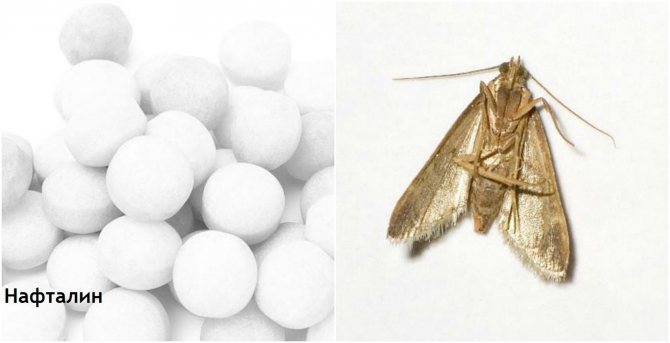

In order to remove pests, you can use fragrant pads made like a sachet. To make them, you need to sew gauze in the shape of a pillow, previously folded in several layers. Next, you need to place in these makeshift pillows any plant that has a pronounced specific smell, for example, mint, wormwood, geranium. Place the bags in the room where the drying is stored.
To remove parasites quickly, it is recommended to smoke beehives or honeycomb storage rooms.In order to obtain it, for the subsequent fumigation of the infected honeycomb, it is required to set fire to combustible sulfur.
It is important to use this method with some caution.
It should be noted that with a strong infection of the honeycomb, the use of alternative methods cannot be effective. Removing large numbers of wax moth larvae may require the use of highly potent insecticides.
Prevention
To prevent infestation by caterpillars, the frames must be properly stored. After the season, you do not need to throw out the frames, they must be stored until next summer, frozen for 2 days. This greatly reduces the likelihood of infection in the hive.
It is also necessary to store frames in a well-lit, well-ventilated area. Airing, insolation creates an unfavorable environment for growth and reproduction.
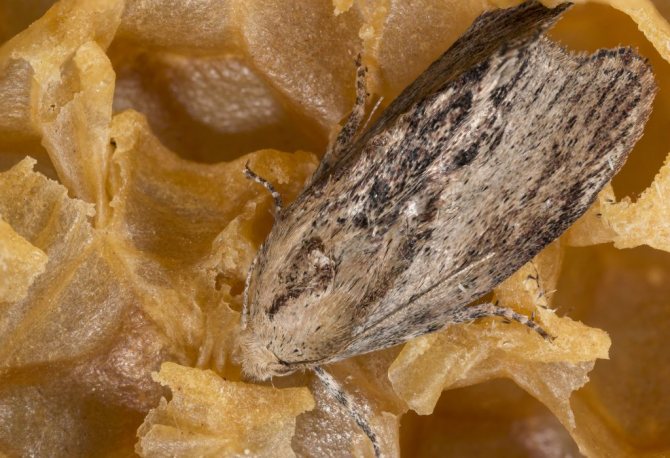

You can use folk remedies, anti-moth or biosafe on a regular basis, since there is no risk of the death of a bee colony, deterioration of the quality of honey.
It is necessary to understand that there are no effective and safe means to destroy the pest. It is important to keep the bees healthy by taking preventive measures. It is necessary to closely monitor young colonies, since it is such families that are affected by insects. Prevention of the appearance, reproduction, spread of the pest and control of it will increase the production of honey and reliably strengthen the beekeeping economy.
Storage protection for sushi
One of the most common questions that worries almost every beekeeper is the preservation of sushi from wax moths. To protect the frames during storage, it is recommended to periodically check them for the presence of pests, removing them if necessary. The room where dryness is stored must be well ventilated.
To scare off the larvae, adult butterflies, it is recommended to use various plants with a pronounced odor, for example, peppermint. The stems should be laid out on the bottom of the boxes, on the floor around the frames. You can put the most ordinary garlic instead of mint, after cutting several cloves into large pieces.
There are some fairly effective chemicals that can also help repel moths quickly.
Means of this kind are plates that are completely harmless to bees, but destructive to wax moths. Such plates should be placed strictly between the frames. They should be changed as needed.


How to prevent the appearance of caterpillars
Preventive steps are most effective against the appearance of a wax moth - then methods of struggle may not be needed at all if you take care of storing sushi in advance.
Airing the store, keeping spare frames separate from the bees, timely replacing old honeycombs with new ones are the main measures, but there are safety measures.
To prevent the appearance of honey moths, plants are used whose smell is repulsive to a harmful insect. To do this, frames are folded into a box, under the lid and at the bottom of which plant raw materials are generously poured, and then corked. In the spring, these combs remain clean and intact.
Used for these purposes:
- leaves tobacco;
- leaves birch, walnut;
- bay leaves;
- flowers marigolds, carnation;
- greens thyme, hops, oregano, mint, wormwood.
Another proven remedy is garlic gruel... It can be used to rub frames, tie them into bags and hang them inside the honeycomb storage.
Signs of moth infestation
To protect bees and bee products from the invasion of a pest, you need to pay attention to the first signs of the appearance of wax moths in the combs. Factors such as the appearance of a thin web, damage to the honeycomb can indicate an infection of the hives. In this case, the level of damage can vary depending on the number of parasites.
At the initial stages of formation, pests eat exclusively bee bread, honey. Subsequently, the diet of insects expands significantly, wax, insulation, and other products produced by bees are used. As the larvae grow, they diligently make moves in the walls of the honeycomb, thereby rendering them unusable.
Harm done
The wax moth is a real disaster for beekeepers... Her voracious larvae feed exclusively on beekeeping products... During development, they are able to bring the hive to such a state that the bee colony cannot withstand such a harmful neighborhood and leaves its home.
At the beginning of its existence, the food of the larva is bee bread and honey. Having become stronger, they already begin to eat honeycomb wax, insulation material, the remains of bee brood. Caterpillars mercilessly spoil the honeycomb, forming numerous tunnels in them.
Moving along the passages made, they leave behind feces and a thin web, sealing the honeycomb with it and not giving the bees the opportunity to lay honey.
Only one caterpillar wax moth during its development capable of damaging up to 500 cell cells and even more. With a large number of pests, almost all combs are filled with cobwebs and turn into dust.
The air in the hive becomes musty and odorless. As a result the bee colony weakens and most often leaves the hive, and in the worst case dies.
Reference! In living quarters, wax moth is not found, since there is nothing to feed its offspring in the house. However, the butterfly can be found in basements, where honeycomb storage facilities are often equipped.
Beekeepers have accumulated considerable experience and have invented many ways to get rid of an uninvited guest. But it should be said that the tincture based on wax moth larvae has many medicinal properties.
Reasons for the defeat of the hive
There are several main reasons for the appearance of pests in storage facilities, hives. Especially often parasites infect old hives, which have a large number of cracks, gaps, in which female wax moths can lay eggs without hindrance. Also insects are attracted by the lack of the necessary cleanliness. The presence of wax or other products of bee production at the bottom of the hives, the larvae of the wax moth can be considered as an invitation card.
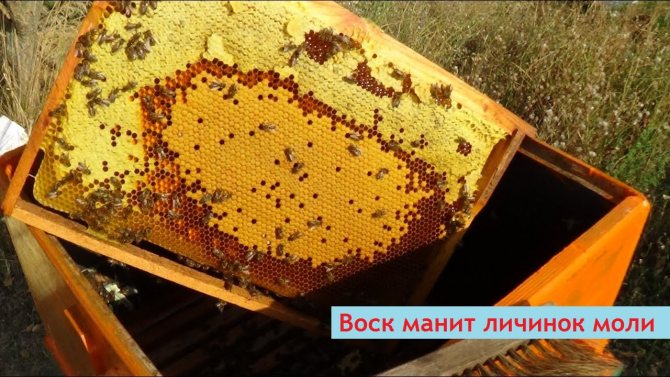

The larvae can move freely between the hives. It is this ability that simply explains such a high level of parasite prevalence. The lack of protective grooves between bee houses, plants that insects are afraid of, leads to the rapid spread of the wax moth.
Life cycle and fertility
Within a few hours after release from the cocoon, the male and female mate. Laying of eggs begins after 2–3 days. At one time, a butterfly is able to postpone up to 300 pieces, the average number is 100-150. The number of clutches in a female during a short life is 4–5 (up to 1500 eggs). Development cycle:
- Ripening of eggs - 8-12 days.
- Larva hatch - size up to 1 mm, whitish-yellow color, 8 pairs of legs.
- Transformation into a caterpillar - length 18 mm, head of a brown shade, lives 25-30 days, sometimes 2 months, during this time it sheds 10 times.
- Pupation - at first the pupa is white, eventually darkens, before the release of a dark brown color (development period is 2 weeks).
- The appearance of a young butterfly.
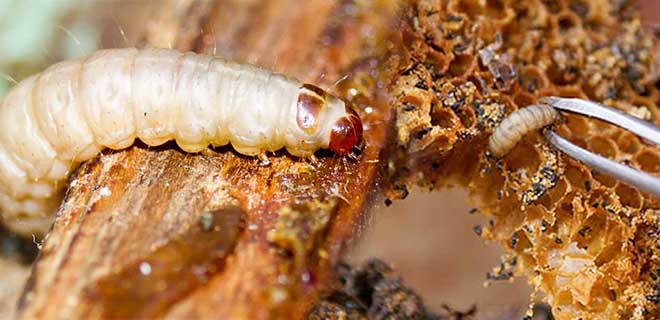

Females lay eggs in secret places in hives. Suitable for cracks and recesses in walls or ceilings, honeycomb frames and cells. The wax moth changes places with each masonry. The larva gnaws a tunnel deep into the honeycomb. To protect itself from bees, it pulls the hole with cobweb yarn. Before pupation, the caterpillars move even deeper - into the cracks, corners and seams of the hives.
Conditions for expanding nests
You can expand the nest in various ways:
- Increase the number of cells.
- Install additional store extensions.
- Unite the bee colony in the case of twin housing.


Expansion of nests is best done in spring.
It is necessary to expand the nests in the spring, when the bee colony desperately needs additional space. This is also a preparation for the main bribe. It is necessary to add frames with dry land in a timely manner and in the right amount. Otherwise, the nest may become overcooled and lag behind in development.
It is also recommended to expand nests when there is a large amount of brood in them. In this case, the seeding of the uterus should be on the extreme frame. If larvae appear on the extreme frame, or the bees find themselves behind the outpost board, it is necessary to add frames with dry land.
It is necessary to expand the nests when there is a large amount of brood in the nests. If a printed brood or larvae appears on the extreme frame, it is urgent to set dry. In the event that bees appear behind the gate, the nest should also be expanded. When expanding nests, the beekeeper should carefully inspect the hive once a week, adding dryness to various places in the hive.
Please note: the fresh frame should not separate from the one with the brood, as it can cool down.


